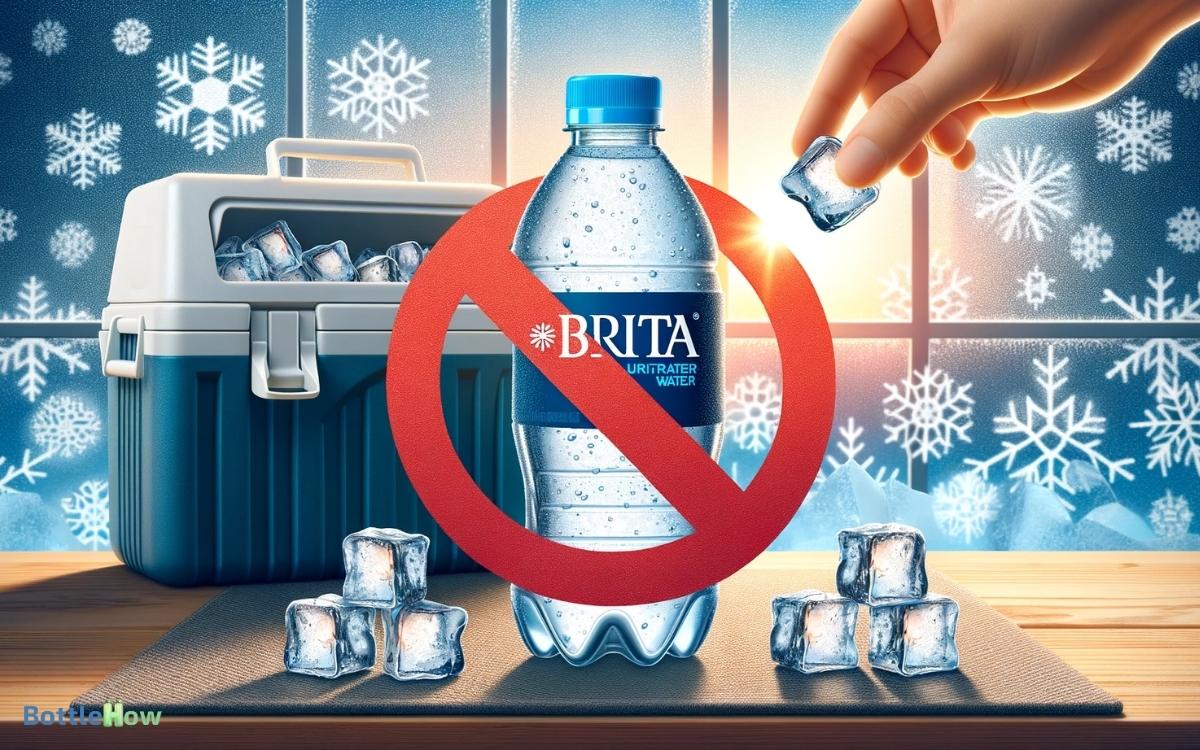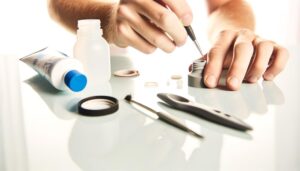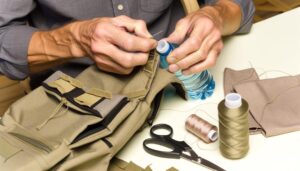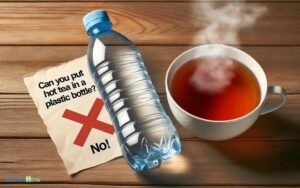Can You Put Ice in a Brita Water Bottle? Yes!
Yes, you can put ice in a Brita water bottle, but it’s important to keep in mind its impact. Ice can obstruct the filter, leading to reduced filtration efficiency and a slower pour rate.
Cold temperatures can alter the activated carbon’s absorption capability, and ice expansion might stress the bottle’s BPA-free materials, potentially leading to microfracture.
The bottle’s insulating design guarantees cold temperatures are retained, but overfilling with ice may cause spills or leaks.
For best performance, think about pre-chilling the bottle or using reusable ice packs instead. To understand the best practices and alternative methods, keep exploring more information.

Key Takeaways
Understanding Brita Water Bottles
Brita water bottles are designed with built-in filters that remove impurities, providing you with clean, great-tasting water on the go.
When you fill your Brita bottle, the water passes through an activated carbon filter. This filter captures chlorine, particulate matter, and other contaminants, greatly improving both taste and safety.
The filtration mechanism is engineered to be highly efficient, ensuring that each sip meets quality standards. You’ll also notice the ergonomic design, which makes it convenient to carry and drink from.
The lid is typically designed to prevent leaks, and the materials used are BPA-free, ensuring no harmful chemicals leach into your water.
Understanding these features helps you appreciate the technology and precision involved in delivering purified hydration.
Benefits of Cold Water
Cold water offers numerous benefits, enhancing both physical performance and overall well-being.
When you consume cold water, it helps regulate your body temperature, especially during intense physical activities. This thermoregulation can prevent overheating and improve endurance.
Additionally, cold water boosts your metabolism, as your body uses energy to warm the water to its core temperature. This process can aid in weight management.
Moreover, cold water enhances mental alertness by stimulating nerve endings and increasing adrenaline levels.
Additionally, it can reduce inflammation and muscle soreness post-exercise, accelerating recovery.
Ice Compatibility
When you put ice in a Brita water bottle, consider how it might affect filter performance and bottle durability.
Ice can potentially obstruct water flow, reducing filtration efficiency. Additionally, repeated ice usage could strain the bottle’s structural integrity over time.
Filter Performance Impact
Inserting ice into a Brita water bottle can subtly alter the filter’s performance, as the temperature change affects water flow and filtration efficiency.
When you add ice, the colder temperature can influence how the activated carbon and ion-exchange resin in the filter operate.
Specifically, colder temperatures can:
- Reduce Water Flow Rate: Colder water moves more slowly through the filter, potentially decreasing overall filtration speed.
- Affect Filtration Efficiency: The filter media mightn’t remove contaminants as effectively at lower temperatures.
- Change Filter Longevity: Prolonged exposure to cold water could impact the filter’s lifespan, necessitating more frequent replacements.
Bottle Durability Concerns
While the impact on filter performance is significant, you should also consider how ice affects the durability of the Brita water bottle itself.
Ice can expand and contract, potentially stressing the bottle‘s material. Brita bottles, typically made from BPA-free plastic, are engineered to withstand regular use, but they aren’t designed for extreme temperature fluctuations.
Introducing ice might cause microfractures over time, compromising the structural integrity.
Additionally, repeated ice insertion could scratch the interior surface, creating small crevices where bacteria might proliferate.
If the bottle is dropped while containing ice, the risk of cracking or breaking increases. It’s important to weigh these durability concerns before deciding to regularly put ice in your Brita water bottle.
Filter Functionality
The Brita water bottle’s filter is designed to efficiently remove impurities and enhance taste, ensuring you get clean and invigorating hydration every time.
The filter uses activated carbon to trap contaminants and improve water quality. As you fill the bottle, water passes through the filtration system, which targets:
- Chlorine: It reduces chlorine taste and odor, making the water more palatable.
- Particulates: It captures sediment and other particles, enhancing clarity.
- Heavy Metals: It minimizes lead and other harmful metals, ensuring safer drinking water.
Potential Issues
You might encounter several potential issues when putting ice in a Brita water bottle, which could impact both the filtration process and the integrity of the bottle itself.
First, the ice could obstruct the filter, reducing water flow and efficiency. If the ice melts unevenly, it might create air pockets, disrupting the filtration system.
Additionally, rapid temperature changes from the ice can stress the plastic, potentially causing cracks or weakening the bottle over time.
The filter itself could also suffer; extreme cold can affect the activated carbon’s absorption efficiency, compromising water quality.
Lastly, overfilling with ice might lead to spills or leaks, especially if the lid isn’t securely closed. Each of these factors warrants careful consideration.
Types of Ice
When choosing between cubed and crushed ice for your Brita water bottle, you must consider how ice size impacts cooling efficiency and water flow.
Cubed ice typically lasts longer, but may obstruct the filtration process. Crushed ice cools water quickly, yet it can clog the filter if not used carefully.
Cubed Vs. Crushed
Choosing between cubed and crushed ice for your Brita water bottle hinges on understanding their respective impacts on cooling efficiency and water flow.
Cubed ice, due to its larger surface area, melts slower, providing prolonged cooling but may restrict water flow.
In contrast, crushed ice melts faster, offering rapid cooling but potentially diluting your water more quickly.
Consider the following points:
- Cooling Efficiency: Cubed ice cools longer, whereas crushed ice cools faster.
- Water Flow: Cubed ice might block the bottle’s spout, while crushed ice allows smoother flow.
- Melting Rate: Crushed ice melts quickly, increasing water volume, while cubed ice maintains a more consistent temperature.
Deciding on the type of ice requires balancing these factors to meet your specific hydration needs.
Ice Size Matters
Understanding the various types of ice, from nugget to sphere, is crucial for maximizing both the cooling efficiency and drinking experience of your Brita water bottle.
Nugget ice, known for its chewable texture, cools quickly but melts faster, potentially diluting your water sooner.
Sphere ice, with its larger surface area, melts slowly and provides prolonged cooling without rapid dilution.
Cubed ice offers a balanced option, providing moderate cooling and slower melting compared to crushed ice.
When considering ice size, make sure it fits through the bottle’s opening without obstructing the filter.
Each type affects the filtration process differently, so choose accordingly to maintain excellent water quality and invigorating coolness.
Using Ice Safely
Make sure you use clean, properly sized ice cubes to avoid damaging your Brita water bottle and to maintain peak water filtration.
Using contaminated ice can introduce harmful bacteria and sediments into your water, compromising the filter’s effectiveness.
To use ice safely, follow these guidelines:
- Guarantee ice cubes are small enough: Large cubes can crack the bottle or obstruct the filter, reducing water flow.
- Use filtered water for ice: This avoids introducing impurities that could clog the filter or degrade water quality.
- Inspect the ice tray: Ensure it’s clean and free from residues that could transfer to the ice and subsequently into your water bottle.
Adhering to these practices will help you enjoy safe, clean, and invigorating water.
Cleaning Considerations
Proper cleaning of your Brita water bottle is essential to maintain its filtration efficiency and guarantee the taste and safety of your water.
Regularly disassemble your bottle to clean each part thoroughly. Use warm, soapy water and a soft brush. Rinse all components well to remove any soap residues.
Avoid using harsh chemicals or abrasive materials, as these can damage the filter and bottle components.
Here’s a quick guide:
| Component | Cleaning Method |
|---|---|
| Bottle | Warm soapy water, brush |
| Cap | Warm soapy water, brush |
| Filter | Rinse with cold water |
| Mouthpiece | Warm soapy water, brush |
Reassemble once completely dry. Regular maintenance ensures top performance and longevity of your Brita water bottle.
User Experiences
When you put ice in a Brita water bottle, you’ll notice variations in ice melting speed that can affect the temperature retention time of your water.
Additionally, consider how the presence of ice impacts filter functionality, potentially slowing down the filtration process.
Users often report that these factors influence their overall experience, particularly in maintaining desired water temperature and ensuring effective filtration.
Ice Melting Speed
Many users have observed that the ice in a Brita water bottle tends to melt more slowly due to the bottle’s insulating properties.
This observation can be attributed to several factors:
- Material Composition: The bottle’s walls are often made from BPA-free plastic, which provides a moderate level of thermal insulation.
- Design Efficiency: The design minimizes external heat transfer, preserving the ice for a longer duration.
- Seal Integrity: The tight lid prevents warm air from entering, reducing the rate of ice melting.
Filter Functionality Impact
In addition, the Brita water bottle’s design efficiently slows ice melting. Users have also noted how the integrated filter impacts their overall hydration experience.
The filter’s primary function is to remove impurities, but it can also affect water flow. You might experience a slower pour rate, which some users find inconvenient, especially during intense physical activities.
Moreover, the filter can occasionally become clogged with ice particles, reducing its effectiveness temporarily. However, many still appreciate the crisp, clean taste that the filter provides.
Regular maintenance, like rinsing the filter and ensuring proper ice size, can mitigate these issues.
Overall, understanding these dynamics helps you maximize the benefits of using a Brita water bottle with ice.
Temperature Retention Time
Users report that the Brita water bottle effectively retains cold temperatures for several hours, enhancing the overall drinking experience.
This capability is particularly beneficial for those who prefer their water chilled. The double-wall insulation technology plays a vital role in this temperature retention.
Key insights from user experiences include:
- Duration: Many users note that the bottle keeps water cold for up to 24 hours.
- Consistency: Even in warmer environments, the water remains pleasantly cool for extended periods.
- Practicality: The bottle’s design accommodates ice cubes without compromising the filtration system’s efficiency.
These insights underscore the Brita bottle’s ability to maintain desirable drinking temperatures, making it an excellent choice for both everyday use and outdoor activities.
Alternative Cooling Methods
Exploring alternative cooling methods for your Brita water bottle can enhance its usability during hot weather conditions.
A practical solution involves pre-chilling the water bottle. Fill it partially with water and place it in the freezer until the water hardens into ice.
Before use, top it off with fresh water. This method maintains cooler temperatures without needing ice cubes.
Additionally, consider using reusable ice packs. These can be placed around the bottle or within an insulated sleeve to provide sustained cooling.
Another option is utilizing a vacuum-insulated sleeve designed specifically for water bottles. These sleeves greatly reduce heat transfer, keeping your water cold for longer periods.
Each method offers a distinct advantage, ensuring you have cool water throughout the day.
Best Practices
To maximize the efficiency of your Brita water bottle, it’s essential to follow specific best practices that guarantee top cooling and filtration performance.
Ensuring ideal use involves more than just adding ice; you need to maintain the integrity of the filter and bottle.
- Pre-chill your bottle: Before adding ice, place the bottle in the refrigerator for an hour. This helps maintain cooler temperatures longer.
- Use crushed ice: Crushed ice fits better through the bottle’s opening and melts faster, providing quicker cooling without obstructing the filter.
- Regularly replace the filter: A clogged or old filter reduces efficiency. Change it as recommended by Brita, typically every two months.
Conclusion
So, can you put ice in a Brita water bottle? The answer might surprise you. While the crisp, cold refreshment of ice water seems ideal, the interaction between ice and Brita’s intricate filtration system is more complex than you might think. Ice cubes can obstruct the straw or filter, potentially slowing down the flow of water as you drink. Additionally, if the ice is too large, it might not easily fit through the bottle’s opening, making it less convenient for users. However, if you’re looking for alternatives, you may wonder how a Kanken water bottle fit compares in terms of size and functionality.
Do the benefits of chilled water outweigh potential issues with filter performance and cleaning maintenance?
Only careful consideration and experimentation will reveal whether the cold truth aligns with your hydration needs.





